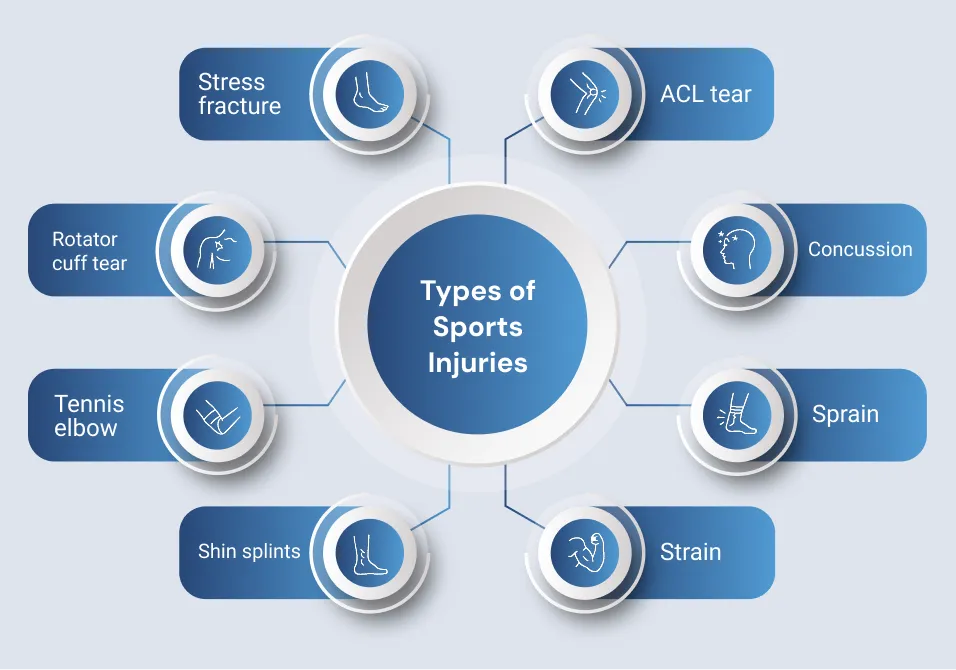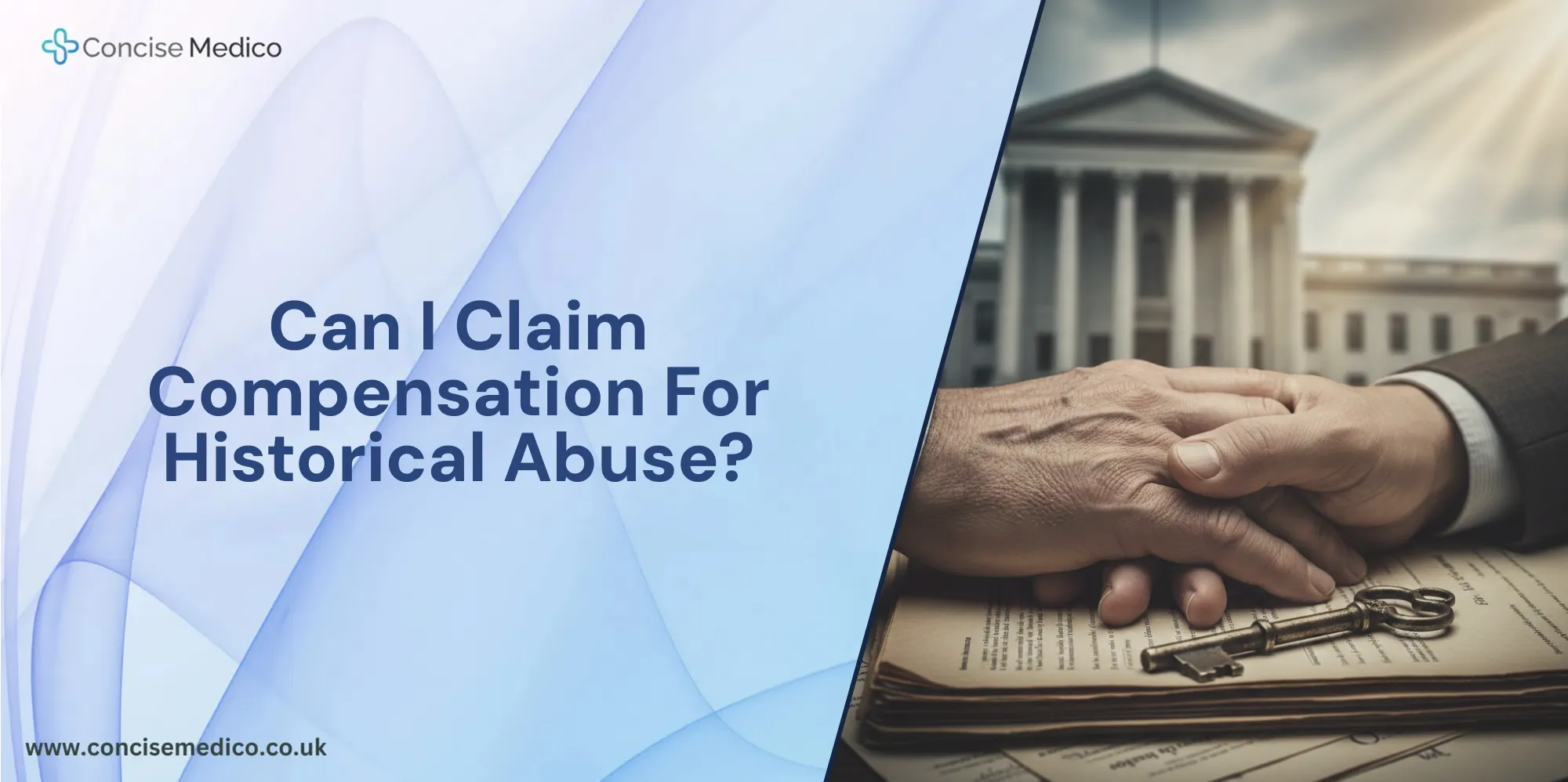TABLE OF CONTENT
- What Is Sports Injury Rehabilitation
- Types of Sports Injuries
- Step-by-Step Sports Injury Rehabilitation Process
- Why Sports Rehab Matters
- Who Delivers Sports Rehab?
- Use of Technology in Rehabilitation
- Nutrition and Hydration in Recovery
- Prevention: Key to Long-Term Success
- Best Practices in Sports Injury Rehabilitation
- FAQs
Sports injury rehabilitation helps you return back from strains, sprains and minor fractures. In sports rehabilitation, a therapist teaches you simple exercises. He will check your progress and adjust your plan accordingly. You’ll rebuild strength, restore movement and feel ready to play again.
What Is Sports Injury Rehabilitation
Sports injury rehabilitation supports athletes in their recovery process. The main aims are to build muscle, soothe pain, and dodge future injuries. It covers everything from initial care to a full return to sport.
Sports injury therapy is all about fast recovery for athletes. This is not the same as general physical therapy, which covers a wider range. It provides training for specific sports. It also provides mental health support and nutrition tips to aid in recovery.
Types of Sports Injuries
ACL Tear
A key knee ligament rips during sudden stops or twists. You might hear a loud pop and feel your knee crumple. Swelling and pain set in fast, making it hard to bear weight or bend the joint.
Concussion
When your head takes a hit, the brain can bump inside your skull. You may feel faint, sick, or clouded right away. You must rest and keep still. After a few days, try gentle head and neck moves. Go slow so the ache does not flare up again.
Sprain
A sprain happens when the soft band around a joint stretches too far or tears, often in the ankle. The area swells and may turn purple in hours. Wrap it lightly and move it a bit each day. This keeps the joint from locking up and helps it heal.
Strain
A strain occurs when a muscle or its cord tears under too much force. You feel a quick jab of pain and then stiffness. Let the spot rest, press cool ice on it, and do gentle stretches. This eases the tightness and brings back your free movement.

Shin splints
In this case,pain runs along the front of the lower leg. It often flares up after running on hard surfaces or increasing workout intensity. Slower speed and proper footwear can reduce the burn.
Tennis elbow
Forearm tendons swell from repetitive arm use. Lifting a racket or twisting a wrench can send a sharp pain through your elbow. Simple wrist stretches and reduced grip strain bring quick relief.
Rotator cuff tear
The rotator cuff are tendons in your shoulder that help you lift your arm. If they tear, you may struggle to raise your arm or lie on that side. Simple shoulder lifts and soft arm circles build strength again and calm the ache.
Stress fracture
A stress fracture is a tiny crack in a bone caused by too much pressure. At first you sense a low ache. When you walk or stand, it hurts more. Keep weight off it and stick to slow walks or swimming. That gives the bone the time it needs to mend.
Step-by-Step Sports Injury Rehabilitation Process
A complete rehabilitation process sports injury plan goes through five key stages. Each phase has a role in recovery and should be guided by a specialist.
1. Rest and Acute Phase Care
The initial 48 to 72 hours following a sports injury is vital. This stage defines the path for recovery after a sports injury. The main goal is to manage pain and swelling early. This helps the body recover without extra stress. One of the most trusted methods in this phase of rehab sports is the RICE model.
Rest
Stop using the injured area right away. Rest gives the damaged tissues time to recover. Don’t put weight or strain on the injury while you’re in this stage of sports rehabilitation.
Ice
Make use of a cold compress for 15 to 20 minutes every 2–3 hours. Cold therapy reduces bleeding, swelling, and pain. It works best in the first 48 hours. Many therapists recommend it for sports injuries.
Compression
Cover the injured spot with a tender wrap. Contraction helps with inflammation. It also supports the joint or muscle. This is a common step in sports injury rehabilitation protocols.

Elevation
Prop the injured limb so it sits above your heart. This lift helps drain extra fluid, cuts down swelling, and eases pain. It’s one of the first steps in most sports injury rehab plans.
2. Mobility and Strength Recovery
Once your pain eases, you move into stage two of sports injury rehabilitation restoring movement and power. A therapist may use hands‑on work, gentle joint glides and soft‑tissue massage, to loosen tight spots. These techniques, teamed with focused exercise, rebuild strength and improve how you move. This stage focuses on:
- ‘Stretching’ to improve movement
- ‘Strengthening exercises’ to support joints
- ‘Balance drills’ to improve coordination
All of these fall under rehabilitation in sports and should be guided by a physiotherapist or rehab trainer.
3. Sport-Specific Training
This is when the body is stronger and ready for sport-like activity. During this rehab phase, your team will start drills that fit your sport. Proprioceptive training helps with body awareness. You can use balance boards or wobble cushions for this. It sets you up for safe, sport-like drills in your chosen activity.
For runners, this means easy treadmill workouts. They should include short intervals and simple strength exercises to boost every step. Footballers use focused drills to enhance their skills. These drills help with ball control, quick cuts, and smooth direction changes. At every turn, sports injury rehabilitation specialists watch your form, tweak your plan, and keep new injuries from happening.
Adrian Peterson’s ACL Comeback
In 2011, while running Peterson tore his ACL and MCL. His rehab combined targeted strength training, plyometrics, balance work, and gradual on-field drills over nine months. Peterson returned in September 2012 to rush for 2,097 yards and win NFL MVP.
4. Mental and Emotional Support
Rehab can bring worry, doubt, or low moods for athletes. As stated by Bae:
“The biopsychosocial approach is an integrated approach that examines biological, psychological, and social factors to identify the causes and treatment of disease.”
Bae, 2024
Mental support during the sports rehabilitation process keeps you positive and focused. A sports psychologist can lift your motivation and ease any worry about getting hurt again. Simple tools like deep breathing and setting clear goals, often work wonders. Electrotherapy devices i.e. TENS or ultrasound can ease stubborn aches. When pain eases, you can pay more attention to your mindset. Caring for your mind is as crucial as healing your body in sports injury rehab.
5. Return to Sport and Prevention
In the final phase of sports rehabilitation, you ease back into full play step by step. Rushing ahead or skipping stages can cause new damage. Functional drills such as plyometric jumps and ladder footwork, mirror real game moves. They teach fresh techniques and lower the risk of future injuries.
Trainers guide you through progressive training. Runners begin by walking, then they jog, and finally, they do full runs. You’ll also get tips to help you use proper techniques and avoid repetitive strain.
A good rehab sports plan always ends with a focus on injury prevention.
Why Sports Rehab Matters
In the UK, sports injuries are common. Between 2023–24 season, Europe’s top five leagues recorded 4,123 injuries, a 4% increase on the previous year, highlighting the impact of unresolved injuries on players’ careers. The NHS spends millions each year on the lasting effects of untreated injuries.
That’s why sports injury rehabilitation must be managed early. A good plan saves athletes from NHS visits and stays active longer.
Who Delivers Sports Rehab?
A strong sports injury rehabilitation program involves many experts:
- Physiotherapists help with movement and joint care.
- Orthopedic doctors look at the healing process of bones and joints.
- Nutritionists plan recovery meals.
- Mental health experts work on mindset.
This team guides each stage of your recovery. They heal bones and joints, rebuild strength, plan meals, and support your mind. That way, you return to sports safe and confident.
Use of Technology in Rehabilitation
In modern rehabilitation in sports, technology plays a big role. New tools make rehab faster and more accurate.
- Ultrasound therapy enhances blood flow to tissues as they heal.
- Electrical stimulation helps to prevent muscle loss.
- Motion sensors track movement in real time.
These tools provide therapists with real-time data. They help adjust your program. They also help you stay focused on recovery goals.
Nutrition and Hydration in Recovery
Sports injury rehabilitation is not only about exercise. Your body needs fuel to heal. A recovery diet includes:
- Proteins to repair muscle
- Anti-inflammatory foods like berries and fish
- Water to flush toxins and support cell repair
Some UK rehab centres work with dietitians. They create meal plans that match your injury and fitness level.
Prevention: Key to Long-Term Success
Good sports injury rehabilitation programs don’t just heal injuries. They teach athletes how to prevent them. Tips include:
- Warm up properly before playing
- Use the right gear e.g. knee brace
- Listen to your body and don’t ignore pain
- Don’t rush back after an injury
Best Practices in Sports Injury Rehabilitation
Every injury heals in its own time. A plan made just for you, steady effort, and patience help you regain your strength, move easily, and trust your body again.
At Concise Medico, our team gives custom support for sports rehab. We’re here to lend a hand with physical therapy, mental clarity, and injury protection.
Contact us and organise your consultation with Concise Medico today.
FAQs
Sports injury rehabilitation helps you return back from strains, sprains and minor fractures. In sports rehabilitation, a therapist teaches you simple exercises. He will check your progress and adjust your plan accordingly. You’ll rebuild strength, restore movement and feel ready to play again.
What Is Sports Injury Rehabilitation
Sports injury rehabilitation supports athletes in their recovery process. The main aims are to build muscle, soothe pain, and dodge future injuries. It covers everything from initial care to a full return to sport.
Sports injury therapy is all about fast recovery for athletes. This is not the same as general physical therapy, which covers a wider range. It provides training for specific sports. It also provides mental health support and nutrition tips to aid in recovery.
Types of Sports Injuries
ACL Tear
A key knee ligament rips during sudden stops or twists. You might hear a loud pop and feel your knee crumple. Swelling and pain set in fast, making it hard to bear weight or bend the joint.
Concussion
When your head takes a hit, the brain can bump inside your skull. You may feel faint, sick, or clouded right away. You must rest and keep still. After a few days, try gentle head and neck moves. Go slow so the ache does not flare up again.
Sprain
A sprain happens when the soft band around a joint stretches too far or tears, often in the ankle. The area swells and may turn purple in hours. Wrap it lightly and move it a bit each day. This keeps the joint from locking up and helps it heal.
Strain
A strain occurs when a muscle or its cord tears under too much force. You feel a quick jab of pain and then stiffness. Let the spot rest, press cool ice on it, and do gentle stretches. This eases the tightness and brings back your free movement.

Shin splints
In this case,pain runs along the front of the lower leg. It often flares up after running on hard surfaces or increasing workout intensity. Slower speed and proper footwear can reduce the burn.
Tennis elbow
Forearm tendons swell from repetitive arm use. Lifting a racket or twisting a wrench can send a sharp pain through your elbow. Simple wrist stretches and reduced grip strain bring quick relief.
Rotator cuff tear
The rotator cuff are tendons in your shoulder that help you lift your arm. If they tear, you may struggle to raise your arm or lie on that side. Simple shoulder lifts and soft arm circles build strength again and calm the ache.
Stress fracture
A stress fracture is a tiny crack in a bone caused by too much pressure. At first you sense a low ache. When you walk or stand, it hurts more. Keep weight off it and stick to slow walks or swimming. That gives the bone the time it needs to mend.
Step-by-Step Sports Injury Rehabilitation Process
A complete rehabilitation process sports injury plan goes through five key stages. Each phase has a role in recovery and should be guided by a specialist.
1. Rest and Acute Phase Care
The initial 48 to 72 hours following a sports injury is vital. This stage defines the path for recovery after a sports injury. The main goal is to manage pain and swelling early. This helps the body recover without extra stress. One of the most trusted methods in this phase of rehab sports is the RICE model.
Rest
Stop using the injured area right away. Rest gives the damaged tissues time to recover. Don’t put weight or strain on the injury while you’re in this stage of sports rehabilitation.
Ice
Make use of a cold compress for 15 to 20 minutes every 2–3 hours. Cold therapy reduces bleeding, swelling, and pain. It works best in the first 48 hours. Many therapists recommend it for sports injuries.
Compression
Cover the injured spot with a tender wrap. Contraction helps with inflammation. It also supports the joint or muscle. This is a common step in sports injury rehabilitation protocols.

Elevation
Prop the injured limb so it sits above your heart. This lift helps drain extra fluid, cuts down swelling, and eases pain. It’s one of the first steps in most sports injury rehab plans.
2. Mobility and Strength Recovery
Once your pain eases, you move into stage two of sports injury rehabilitation restoring movement and power. A therapist may use hands‑on work, gentle joint glides and soft‑tissue massage, to loosen tight spots. These techniques, teamed with focused exercise, rebuild strength and improve how you move. This stage focuses on:
- ‘Stretching’ to improve movement
- ‘Strengthening exercises’ to support joints
- ‘Balance drills’ to improve coordination
All of these fall under rehabilitation in sports and should be guided by a physiotherapist or rehab trainer.
3. Sport-Specific Training
This is when the body is stronger and ready for sport-like activity. During this rehab phase, your team will start drills that fit your sport. Proprioceptive training helps with body awareness. You can use balance boards or wobble cushions for this. It sets you up for safe, sport-like drills in your chosen activity.
For runners, this means easy treadmill workouts. They should include short intervals and simple strength exercises to boost every step. Footballers use focused drills to enhance their skills. These drills help with ball control, quick cuts, and smooth direction changes. At every turn, sports injury rehabilitation specialists watch your form, tweak your plan, and keep new injuries from happening.
Adrian Peterson’s ACL Comeback
In 2011, while running Peterson tore his ACL and MCL. His rehab combined targeted strength training, plyometrics, balance work, and gradual on-field drills over nine months. Peterson returned in September 2012 to rush for 2,097 yards and win NFL MVP.
4. Mental and Emotional Support
Rehab can bring worry, doubt, or low moods for athletes. As stated by Bae:
“The biopsychosocial approach is an integrated approach that examines biological, psychological, and social factors to identify the causes and treatment of disease.”
Bae, 2024
Mental support during the sports rehabilitation process keeps you positive and focused. A sports psychologist can lift your motivation and ease any worry about getting hurt again. Simple tools like deep breathing and setting clear goals, often work wonders. Electrotherapy devices i.e. TENS or ultrasound can ease stubborn aches. When pain eases, you can pay more attention to your mindset. Caring for your mind is as crucial as healing your body in sports injury rehab.
5. Return to Sport and Prevention
In the final phase of sports rehabilitation, you ease back into full play step by step. Rushing ahead or skipping stages can cause new damage. Functional drills such as plyometric jumps and ladder footwork, mirror real game moves. They teach fresh techniques and lower the risk of future injuries.
Trainers guide you through progressive training. Runners begin by walking, then they jog, and finally, they do full runs. You’ll also get tips to help you use proper techniques and avoid repetitive strain.
A good rehab sports plan always ends with a focus on injury prevention.
Why Sports Rehab Matters
In the UK, sports injuries are common. Between 2023–24 season, Europe’s top five leagues recorded 4,123 injuries, a 4% increase on the previous year, highlighting the impact of unresolved injuries on players’ careers. The NHS spends millions each year on the lasting effects of untreated injuries.
That’s why sports injury rehabilitation must be managed early. A good plan saves athletes from NHS visits and stays active longer.
Who Delivers Sports Rehab?
A strong sports injury rehabilitation program involves many experts:
- Physiotherapists help with movement and joint care.
- Orthopedic doctors look at the healing process of bones and joints.
- Nutritionists plan recovery meals.
- Mental health experts work on mindset.
This team guides each stage of your recovery. They heal bones and joints, rebuild strength, plan meals, and support your mind. That way, you return to sports safe and confident.
Use of Technology in Rehabilitation
In modern rehabilitation in sports, technology plays a big role. New tools make rehab faster and more accurate.
- Ultrasound therapy enhances blood flow to tissues as they heal.
- Electrical stimulation helps to prevent muscle loss.
- Motion sensors track movement in real time.
These tools provide therapists with real-time data. They help adjust your program. They also help you stay focused on recovery goals.
Nutrition and Hydration in Recovery
Sports injury rehabilitation is not only about exercise. Your body needs fuel to heal. A recovery diet includes:
- Proteins to repair muscle
- Anti-inflammatory foods like berries and fish
- Water to flush toxins and support cell repair
Some UK rehab centres work with dietitians. They create meal plans that match your injury and fitness level.
Prevention: Key to Long-Term Success
Good sports injury rehabilitation programs don’t just heal injuries. They teach athletes how to prevent them. Tips include:
- Warm up properly before playing
- Use the right gear e.g. knee brace
- Listen to your body and don’t ignore pain
- Don’t rush back after an injury
Best Practices in Sports Injury Rehabilitation
Every injury heals in its own time. A plan made just for you, steady effort, and patience help you regain your strength, move easily, and trust your body again.
At Concise Medico, our team gives custom support for sports rehab. We’re here to lend a hand with physical therapy, mental clarity, and injury protection.
Contact us and organise your consultation with Concise Medico today.




